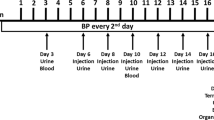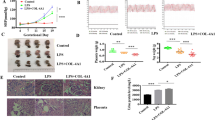Abstract
Gestational hypertension is a leading cause of both prenatal and maternal mortality and morbidity; however, there have been rather limited advances in the management of gestational hypertension in recent years. There has been evidence supporting the antihypertensive properties of crocin, but the specific mechanism is still unclear. N-Nitro-L-arginine methyl ester (L-NAME) was employed to establish a rat model with a preeclampsia-like phenotype, particularly gestational hypertension. Enzyme-linked immunosorbent assays were conducted to determine the levels of placental growth factor (PlGF) and soluble fms-like tyrosine kinase (sFlt-1); the levels of the circulating cytokines interleukin (IL)-1β, IL-6, and tumor necrosis factor (TNF)-α; and oxidative stress factors. Quantitative RT-PCR assays were performed to assess the transcript levels of various cytokines in the placenta, and western blot assays were carried out to evaluate the protein levels of heme oxygenase-1 (HO-1) and nuclear factor-erythroid 2-like 2 (Nrf-2). Treatment with crocin reduced the blood pressure of rats with gestational hypertension, which was accompanied by suppressed circulating levels of PlGF and sFlt-1. Crocin further alleviated the inflammatory signals and oxidative stress in the serum, as well as in placental tissues, in rats with L-NAME-induced hypertension. Crocin treatment also improved pregnancy outcomes in terms of fetal survival, fetal weight, and the fetal/placental weight ratio. Finally, in hypertension elicited by L-NAME, crocin stimulated the placental Nrf-2/HO-1 pathway. Crocin alleviated inflammatory and oxidative stress in placental tissues, thereby protecting against gestational hypertension, one of the major phenotypes of preeclampsia, and activated the Nrf-2/HO-1 pathway.
This is a preview of subscription content, access via your institution
Access options
Subscribe to this journal
Receive 12 print issues and online access
$259.00 per year
only $21.58 per issue
Buy this article
- Purchase on Springer Link
- Instant access to full article PDF
Prices may be subject to local taxes which are calculated during checkout






Similar content being viewed by others
References
WHO Recommendations for Prevention and Treatment of Pre-Eclampsia and Eclampsia. Geneva; 2011.
Sharf M, Eibschitz I, Hakim M, Degani S, Rosner B. Is Serum Free Estriol Measurement Essential in the Management of Hypertensive Disorders during Pregnancy. Eur J Obstet Gyn R B. 1984;17:365–75.
Visintin C, Mugglestone MA, Almerie MQ, Nherera LM, James D, Walkinshaw S, et al. Guidelines Management of hypertensive disorders during pregnancy: summary oif NICE guidance. Brit Med J. 2010;341.
Savitz DA, Danilack VA, Engel SM, Elston B, Lipkind HS. Descriptive epidemiology of chronic hypertension, gestational hypertension, and preeclampsia in New York State, 1995–2004. Matern Child Health J. 2014;18:829–38.
Schneider S, Freerksen N, Maul H, Roehrig S, Fischer B, Hoeft B. Risk groups and maternal-neonatal complications of preeclampsia–current results from the national German Perinatal Quality Registry. J Perinat Med. 2011;39:257–65.
Larcan A, Lambert H, Laprevote MC, Alexandre P. Disseminated intravascular coagulation and acute renal failure in the field of obstetrics. Bibl Anat. 1975;13:347–50.
Rattray DD, O’Connell CM, Baskett TF. Acute disseminated intravascular coagulation in obstetrics: a tertiary centre population review (1980 to 2009). J Obstet Gynaecol Can. 2012;34:341–7.
Draganovic D, Lucic N, Jojic D. Oxidative Stress Marker and Pregnancy Induced Hypertension. Med Arch. 2016;70:437–40.
Harmon AC, Cornelius DC, Amaral LM, Faulkner JL, Cunningham MW Jr, Wallace K, et al. The role of inflammation in the pathology of preeclampsia. Clin Sci (Lond). 2016;130:409–19.
Matsubara S, Minakami H, Sato I, Saito T. Decrease in cytochrome c oxidase activity detected cytochemically in the placental trophoblast of patients with pre-eclampsia. Placenta. 1997;18:255–9.
van der Graaf AM, Wiegman MJ, Plosch T, Zeeman GG, van Buiten A, Henning RH, et al. Endothelium-dependent relaxation and angiotensin II sensitivity in experimental preeclampsia. PLoS ONE 2013;8:e79884.
Kensler TW, Wakabayashi N, Biswal S. Cell survival responses to environmental stresses via the Keap1-Nrf2-ARE pathway. Annu Rev Pharm Toxicol. 2007;47:89–116.
Kang SJ, You A, Kwak MK. Suppression of Nrf2 signaling by angiotensin II in murine renal epithelial cells. Arch Pharm Res. 2011;34:829–36.
Itoh K, Mimura J, Yamamoto M. Discovery of the negative regulator of Nrf2, Keap1: a historical overview. Antioxid Redox Signal. 2010;13:1665–78.
Kweider N, Huppertz B, Kadyrov M, Rath W, Pufe T, Wruck CJ. A possible protective role of Nrf2 in preeclampsia. Ann Anat. 2014;196:268–77.
Rahaiee S, Moini S, Hashemi M, Shojaosadati SA. Evaluation of antioxidant activities of bioactive compounds and various extracts obtained from saffron (Crocus sativus L.): a review. J Food Sci Technol. 2015;52:1881–8.
Imenshahidi M, Hosseinzadeh H, Javadpour Y. Hypotensive effect of aqueous saffron extract (Crocus sativus L.) and its constituents, safranal and crocin, in normotensive and hypertensive rats. Phytother Res. 2010;24:990–4.
Imenshahidi M, Razavi BM, Faal A, Gholampoor A, Mousavi SM, Hosseinzadeh H. The Effect of Chronic Administration of Saffron (Crocus sativus) Stigma Aqueous Extract on Systolic Blood Pressure in Rats. Jundishapur J Nat Pharm Prod. 2013;8:175–9.
Imenshahidi M, Razavi BM, Faal A, Gholampoor A, Mousavi SM, Hosseinzadeh H. Effects of chronic crocin treatment on desoxycorticosterone acetate (doca)-salt hypertensive rats. Iran J Basic Med Sci. 2014;17:9–13.
Shafei MN, Faramarzi A, Khajavi Rad A, Anaeigoudari A. Crocin prevents acute angiotensin II-induced hypertension in anesthetized rats. Avicenna J Phytomed. 2017;7:345–52.
Kim JH, Park GY, Bang SY, Park SY, Bae SK, Kim Y. Crocin suppresses LPS-stimulated expression of inducible nitric oxide synthase by upregulation of heme oxygenase-1 via calcium/calmodulin-dependent protein kinase 4. Mediators Inflamm. 2014;2014:728709.
Godugu C, Pasari LP, Khurana A, Anchi P, Saifi MA, Bansod SP, et al. Crocin, an active constituent of Crocus sativus ameliorates cerulein induced pancreatic inflammation and oxidative stress. Phytother Res. 2020;34:825–35.
Khodir AE, Said E, Atif H, ElKashef HA, Salem HA. Targeting Nrf2/HO-1 signaling by crocin: Role in attenuation of AA-induced ulcerative colitis in rats. Biomed Pharmacother. 2019;110:389–99.
Kemse NG, Kale AA, Joshi SR. A combined supplementation of omega-3 fatty acids and micronutrients (folic acid, vitamin B12) reduces oxidative stress markers in a rat model of pregnancy induced hypertension. PLoS ONE 2014;9:e111902.
Wang Y, Huang M, Yang X, Yang Z, Li L, Mei J. Supplementing punicalagin reduces oxidative stress markers and restores angiogenic balance in a rat model of pregnancy-induced hypertension. Korean J Physiol Pharmacol. 2018;22:409–17.
Armaly Z, Zaher M, Knaneh S, Abassi Z. [Preeclampsia: Pathogenesis and Mechanisms Based Therapeutic Approaches]. Harefuah. 2019;158:742–7.
Moradi MT, Rahimi Z, Vaisi-Raygani A. New insight into the role of long non-coding RNAs in the pathogenesis of preeclampsia. Hypertens Pregnancy. 2019;38:41–51.
Lv X, Li X, Dai X, Liu M, Wu C, Song W, et al. Investigation heme oxygenase-1 polymorphism with the pathogenesis of preeclampsia. Clin Exp Hypertens. 2020;42:167–70.
Kara AE, Guney G, Tokmak A, Ozaksit G. The role of inflammatory markers hs-CRP, sialic acid, and IL-6 in the pathogenesis of preeclampsia and intrauterine growth restriction. Eur Cytokine Netw. 2019;30:29–33.
Matsubara K, Higaki T, Matsubara Y, Nawa A. Nitric oxide and reactive oxygen species in the pathogenesis of preeclampsia. Int J Mol Sci. 2015;16:4600–14.
Matsubara K, Matsubara Y, Hyodo S, Katayama T, Ito M. Role of nitric oxide and reactive oxygen species in the pathogenesis of preeclampsia. J Obstet Gynaecol Res. 2010;36:239–47.
Sircar M, Thadhani R, Karumanchi SA. Pathogenesis of preeclampsia. Curr Opin Nephrol Hypertens. 2015;24:131–8.
Williams PJ, Searle RF, Robson SC, Innes BA, Bulmer JN. Decidual leucocyte populations in early to late gestation normal human pregnancy. J Reprod Immunol. 2009;82:24–31.
Chen S, Sun P, Zhao X, Yi R, Qian J, Shi Y, et al. Gardenia jasminoides has therapeutic effects on LNNAinduced hypertension in vivo. Mol Med Rep. 2017;15:4360–73.
Raji M, Chen Z. Effects of abiotic elicitors on the production of bioactive flavonols in Emilia sonchifolia. STEMedicine. 2020;1:e33.
Loboda A, Damulewicz M, Pyza E, Jozkowicz A, Dulak J. Role of Nrf2/HO-1 system in development, oxidative stress response and diseases: an evolutionarily conserved mechanism. Cell Mol Life Sci. 2016;73:3221–47.
Ding C, Zou Q, Wu Y, Lu J, Qian C, Li H, et al. EGF released from human placental mesenchymal stem cells improves premature ovarian insufficiency via NRF2/HO-1 activation. Aging (Albany NY). 2020;12:2992–3009.
Chigusa Y, Tatsumi K, Kondoh E, Fujita K, Nishimura F, Mogami H, et al. Decreased lectin-like oxidized LDL receptor 1 (LOX-1) and low Nrf2 activation in placenta are involved in preeclampsia. J Clin Endocrinol Metab. 2012;97:E1862–70.
Talaei A, Hassanpour Moghadam M, Sajadi Tabassi SA, Mohajeri SA. Crocin, the main active saffron constituent, as an adjunctive treatment in major depressive disorder: a randomized, double-blind, placebo-controlled, pilot clinical trial. J Affect Disord. 2015;174:51–6.
Sepahi S, Mohajeri SA, Hosseini SM, Khodaverdi E, Shoeibi N, Namdari M, et al. Effects of Crocin on Diabetic Maculopathy: A Placebo-Controlled Randomized Clinical Trial. Am J Ophthalmol. 2018;190:89–98.
Ghaderi A, Rasouli-Azad M, Vahed N, Banafshe HR, Soleimani A, Omidi A, et al. Clinical and metabolic responses to crocin in patients under methadone maintenance treatment: A randomized clinical trial. Phytother Res. 2019;33:2714–25.
Funding
The study was supported by the Quanzhou Science and Technology Plan Project (2020N022s).
Author information
Authors and Affiliations
Corresponding author
Ethics declarations
Conflict of interest
The authors declare that they have no conflict of interest.
Additional information
Publisher’s note Springer Nature remains neutral with regard to jurisdictional claims in published maps and institutional affiliations.
Rights and permissions
About this article
Cite this article
Chen, X., Huang, J., Lv, Y. et al. Crocin exhibits an antihypertensive effect in a rat model of gestational hypertension and activates the Nrf-2/HO-1 signaling pathway. Hypertens Res 44, 642–650 (2021). https://doi.org/10.1038/s41440-020-00609-7
Received:
Revised:
Accepted:
Published:
Issue Date:
DOI: https://doi.org/10.1038/s41440-020-00609-7
Keywords
This article is cited by
-
Preeclampsia up to date—What’s going on?
Hypertension Research (2023)



